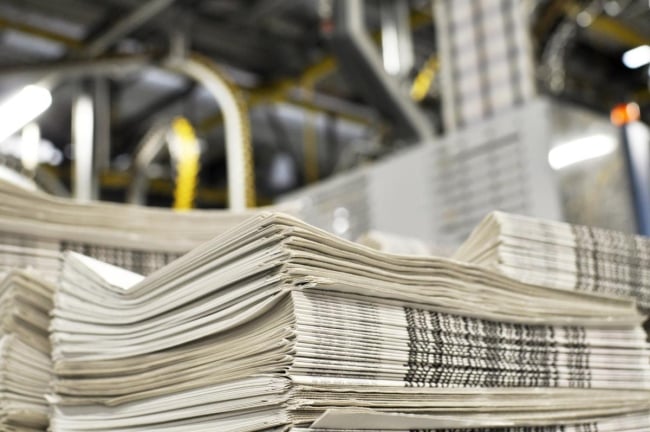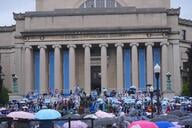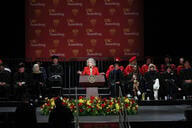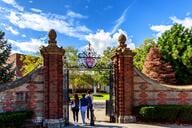You have /5 articles left.
Sign up for a free account or log in.

Nathaniel Greve launched an alternative student newspaper at the Georgia Institute of Technology as a way to help heal what he saw as the flawed political speech environment on campus.
“We were noticing that the way that students were handling their political discourse using platforms such as Reddit, Twitter, Instagram, YikYak, the school newspaper just simply was not a productive means of … making any kind of argument,” said Greve, a junior majoring in computer science. “I think this is a big issue to our school, and it was an issue at schools across the board and just the nation as a whole.”
He said conservative voices were being pushed out of mainstream student news and that the main student newspaper, The Technique, wasn’t serving the student population as well as it could. For one thing, he objected to its tradition of endorsing a candidate for student government president—a tradition shared by a significant but dwindling number of traditional news outlets—arguing that it is not “fair” to use a media platform to “influence students.”
Greve launched The Liberty Jacket in 2021. When The Technique endorsed a candidate in the 2022–23 student government elections, Greve and a fellow student journalist decided to publish what they hoped would be a more objective breakdown of the different candidates’ platforms.
“We believe it is our job to present information on the candidates so that our readers can make their own decisions,” he said.
The Liberty Jacket is one of at least a dozen conservative or right-leaning student newspapers that have launched on college campuses since the beginning of 2020. The papers vary in everything from content—some are opinion-focused, while others include more traditional news stories—to medium; the recently relaunched Harvard Salient, for one, is predominantly print-focused.
But many share a funding source: the Intercollegiate Studies Institute, an organization with chapters across U.S. colleges that trains young people to become conservative leaders. ISI provides grants to at least 50 conservative student publications, according to its website, though details about how much it provides and how that money is used remain murky; one conservative newspaper editor told Inside Higher Ed that their contract with ISI prohibits them from sharing such information.
Of the 14 conservative student papers Inside Higher Ed researched for this story, five listed ISI as a “collaborator,” “friend” or some similar moniker on their websites; another three did not mention ISI up front on their sites, but the organization’s newsletter made reference to them. Some conservative student newspapers also receive funding through donation links on their websites.
‘Open Spread of Ideas’
In addition to a common funding source, many modern conservative student media outlets also share a similar origin story. Like Greve of The Liberty Jacket, other founders say they formed their newspaper or site to create a forum where students could share a range of viewpoints—not just the liberal ones that they say dominate most campuses.
“We created this publication with the idea that the free and open spread of ideas is one of the most important aspects of a functioning democracy in mind,” reads the Welcome page on the website of The Conntrarian, an alternative student paper launched in December 2021 at Connecticut College. “This publication aims to serve as a broad ranging platform full of important discussion that reflects different perspectives to provide a healthy ecosystem of differing viewpoints.”
(Like many newer conservative papers, The Conntrarian does not call itself conservative on its Welcome page. But it was founded by the president of the university’s College Republicans club and has published many right-leaning pieces, including an essay harshly condemning abortion and another arguing that white Connecticut College students face discrimination.)
Indeed, one increasingly common refrain among conservative students on college campuses is that they’re not as free to share their perspectives as liberal students.
Anne Marie Tamburro, a program officer at the Foundation for Individual Rights and Expression, said that the organization, which advocates for free speech, has received at least eight complaints since 2020 from conservative college students claiming they were “shut out” of a student publication due to their political views.
By FIRE’s definition, that does not qualify as censorship; the organization believes independent student newspapers can make whatever decisions they want about what to publish and who can join their staff.
But Tamburro can understand why such a dynamic might lead students to start their own publications.
“Political views lend to strong opinions about what is or what should be represented in news media,” she said. “Students with more controversial views are going to seek out alternate platforms and report how they feel things and stories should be shared.”
Alex DiBranco, a Yale Ph.D. candidate whose work studying the American right wing includes research on the history of conservative student newspapers, said that these sentiments mirror those that drove the original rise of conservative student newspapers in the 1960s, in response to the antiwar movement that pervaded college campuses at the time. Such papers saw a resurgence in the 1980s, beginning with arguably the most famous conservative student paper, The Dartmouth Review, whose coverage, which was widely seen as racist and anti-LGBTQ+, inspired a number of copycats.
“It’s an element of both the late-1960s and the 1980s movements—their perceptions of campuses as excessively liberal,” DiBranco said. “These talking points mirror the talking points of conservatives about mainstream media in general. The ideas are not spontaneously coming out of nowhere.”
Conservative student newspapers have historically been supported by larger conservative organizations, which fund them in the hopes of spreading conservative messages on campuses, DiBranco said.
These organizations—like ISI, which also supported conservative student news in the 1980s and ’90s—need only distribute a small amount of money, especially given that many of the sites are digital only and relatively cheap to produce. In exchange, they get to disseminate their message on college campuses and nurture future supporters.
“That understanding of the importance of student newspapers as a potential means for changing the ideas generated and disseminated on campus was really important to the conservative infrastructure,” DiBranco said. “The conservative infrastructure has a long-term focus on education and public education and universities as the bastion of socialism, communism, anticapitalism, perceiving professors as incredibly liberal, as indoctrinating liberals, and so were seeking ways they could intervene.”
ISI did not respond to a request for an interview.
Controversy Lurks
Like the conservative student papers of yore, today’s publications tend not to shy away from controversial issues.
The Amherst Contra—which doesn’t identify itself as conservative (nor does its editor, Ross Kilpatrick) but similarly aims to spark discourse and publish less common viewpoints—printed an article last October titled “In Defense of Hamas,” prompting a backlash both on and off campus. The article, penned—like most of the Contra’s pieces—by an anonymous author, circulated on Twitter and was covered in a number of Jewish publications.
“Glorifying a foreign terror organization that espouses #antisemitism and hate and is responsible for the killing of so many innocent Israelis, Americans and others, is inexcusable. We expect @AmherstCollege to speak out against this dangerous and misguided article,” the New England office of the Anti-Defamation League, a civil rights organization aimed at ending antisemitism, tweeted at the time.
Kilpatrick, a junior at Amherst, said he regrets the headline, which has since been changed online to “Recontextualizing Hamas,” with an editor’s note briefly describing the controversy. He said the title—as well as the backlash from people outside Amherst—made it harder for the piece to reach Amherst students, his target audience.
“Even though I don’t think the material was necessarily super inflammatory, I think the way we presented it made it so that students didn’t engage with it how I wanted them to engage,” Kilpatrick said.
The Liberty Jacket, too, has tackled some highly contentious issues; the paper published a number of stories on the debate over allowing trans women athletes to compete in women’s leagues—a hot-button subject that has prompted legislation banning or severely limiting trans athletes from participating in sports.
More often than not, the papers’ content revolves around the local community or their campus. At Florida State University, for instance, the alternative Capitol Collegian has found a niche focusing on statewide higher education policy—which, as of late, has mostly involved Florida governor Ron DeSantis working to end diversity programs at public universities. Recent Collegian articles include “College Board Caves After DeSantis Cuts AP African American Studies” and “DeSantis Announces Sweeping Higher Education Reforms to Combat Indoctrination.”
The Liberty Jacket also critiqued Georgia Tech’s Student Government Association for sharing reproductive health resources on social media, arguing that it violated SGA bylaws by failing to represent the interests of antiabortion students. The SGA later removed the post from most platforms (and edited its post on Instagram to remove tips on how to protest safely).
Often highly political posts appear alongside articles more typical of a traditional student newspaper, such as a guide The Liberty Jacket designed to help freshmen decide where to live on campus.
The founders of both The Liberty Jacket and the Collegian said they aimed to be “objective” in their reporting and rigorous in their fact-checking. Greve said his paper established its fact-checking process after initially finding some unsubstantiated claims in early articles that they then had to correct. While the Collegian does not have a formalized fact-checking process, David Glasser, one of the paper’s editors and an FSU senior, said he was familiar with editorial standards through work at other outlets, including the right-wing Daily Caller.
Glasser believes that objectivity is vital if conservative news sites want to be taken seriously.
“You have a campus media ecosystem that has built itself around the idea that ‘we’re the real journalists, we’re going to tell you what’s really going on,’” he said. “There is this idea that we have to the increase the credibility of our ideas.”
Tamburro of FIRE noted that objectivity “is an easy term to throw around, but you need to actually be able to back it up … I think it’s very hard to achieve without a lot of training and feedback from others.”




